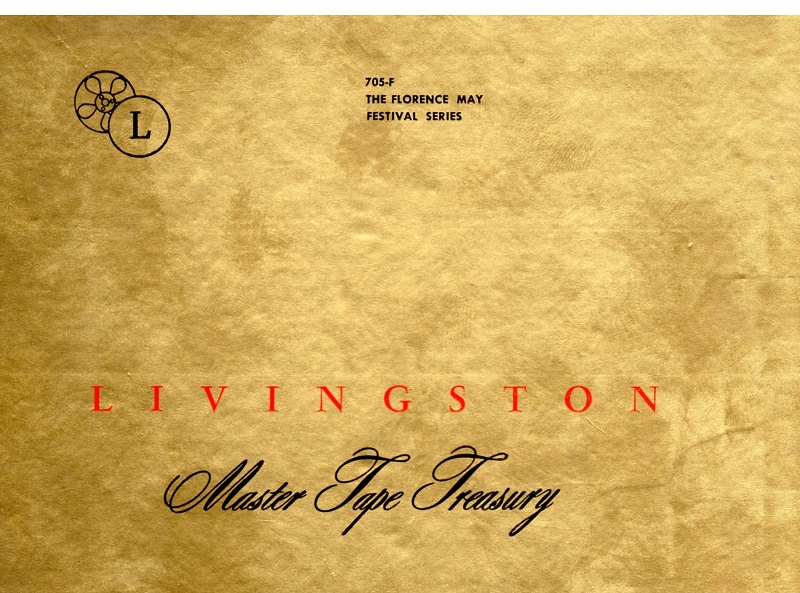
Gui – Schubert Rossini Brahms Massenet Orchestra del Maggio Musicale Fiorentino 1953 Stereo
Vittorio Gui – Orchestra del Maggio Musicale Fiorentino
Schubert Symphonie n°8 D759
Rossini Guillaume Tell Ouverture
Brahms Akademische Festouvertüre Op.80
Massenet-Scènes Alsaciennes: n°3 Sous les Tilleuls
Enr/Rec: Teatro Comunale di Firenze – May – June 1953 Stereo
Source: Bande/Tape Audiosphere 701-BN & Livingston 705F
Le Mai Musical Florentin de 1953 (XVI Maggio Musicale Fiorentino) est resté célèbre en raison des représentations de la Medea de Cherubini avec Maria Callas sous la direction de Vittorio Gui.
Fait moins connu, au cours de ce Festival, ont été réalisés les premiers enregistrements stéréophoniques commerciaux en Europe, sous la direction de Vittorio Gui, pour le label américain Livingston fondé par Ched Smiley.
Le directeur artistique de cette production était le chef Hans Wolf (Hamburg 1912- Seattle 2005). Il a étudié notamment avec Heinrich Schenker en 1933 et 1934 et a poursuivi ensuite des études à Vienne. Comme Marcel Prawy dont il était l‘ami, Il s’est engagé dans l’armée américaine en 1943, a obtenu la nationalité américaine et a été envoyé à Vienne au printemps 1945. Avant de s’installer aux Etats-Unis en 1952, il a fait des enregistrements pour le label Remington et un orchestre dénommé «Austrian Symphony Orchestra« (qui était en fait le Niederösterreichisches Tonkünstler Orchester) entre 1950 et février 1952, en tant que chef d’orchestre (Beethoven Symphonie n°5, Brahms Symphonie n°2, Franck Symphonie etc…). Il a également été producteur associé avec Marcel Prawy, pour les enregistrements avec Fritz Busch avec le même orchestre (Haydn Symphonie n°101, Beethoven Symphonies n°3 et 8) pour lesquels l’ingénieur du son était Hans Sachs de la Radio autrichienne RAVAG) et, fait notable avec Vittorio Gui (Mendelssohn: Symphonie n°5 et Ouverture «Les Hébrides», ainsi qu’un disque d’ouvertures).
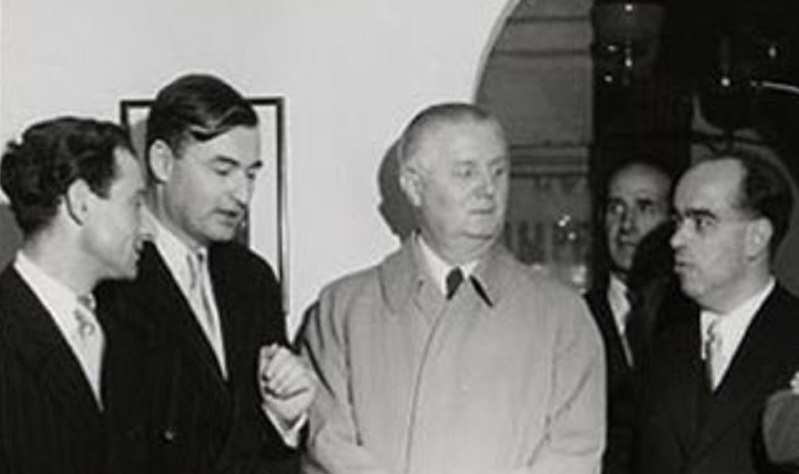
Hans Wolf – Marcel Prawy – Fritz Busch – Hans Sachs – Wien Oktober 1950
Par ailleurs, le label Livingston était à l’époque engagé dans des recherches de stéréophonie expérimentale, notamment avec le concept de disque à double sillon d’Emery Cook, pour lequel Livingston a commercialisé un bras de lecture « Binaural Arm »:
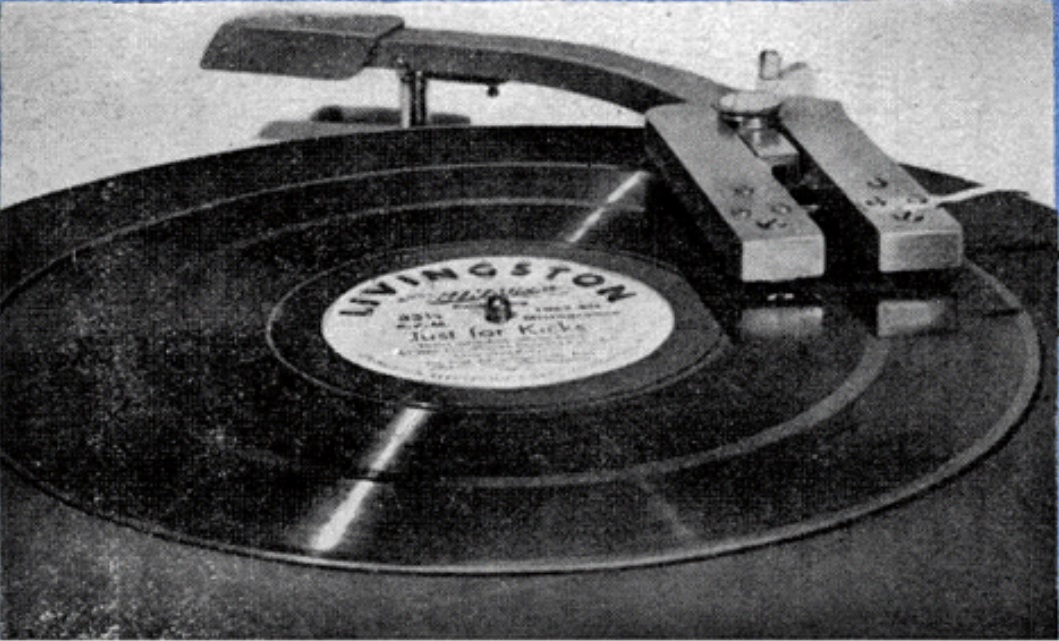
Livingston Binaural Arm
Le nouveau projet de Livingston qui a vu le jour en 1953 était la commercialisation en stéréophonie, sur bandes magnétiques, d’une importante série d’ enregistrements orchestraux faits à Florence sous la direction de Vitorio Gui au cours du Mai Musical Florentin qui a eu lieu entre le 7 mai et le 29 juin 1953. Livingston n’était pas le seul avec un tel projet, mais ses enregistrements orchestraux en stéréo ont précédé ceux d’ AV-Tapes Libraries (Sibelius: Cincinnati SO Thor Johnson enregistré en novembre 1953).
Cinq bandes magnétiques référencées 701 à 705 publiées par Livingston/Audiosphere ont été annoncées dans les numéros de juin et d’août 1954 de la revue Tape Recordings, après avoir fait l’objet au mois de mars d’une présentation au public à Cleveland (Cleveland Chapter 18th Symposium «Stereo Symposium») sous la forme d’émissions radiophoniques FM expérimentales en stéréo.
Lors des séances d’enregistrement à Florence, deux jours ont été consacrés à la mise en place des microphones et à la balance de l’orchestre, le montage des bandes a été réalisé sur place, et les enregistrements ont fait l’objet d’une écoute en vue de leur approbation.

Presentation (Tape Recordings: June 1954)
Dans un article intitulé «Tape makes it easier» paru dans le numéro d’avril 1955 de la Revue «Tape Recordings«, Hans Wolf a dévoilé sa conception personnelle des enregistrements sur bande magnétique et sur le montage, et il a raconté la visite d‘Heinrich Kralik, musicologue et Directeur du département musical de la Radio Autrichienne RAVAG, lors du montage des enregistrements de Vittorio Gui dans une petite salle du Teatro Comunale. Pour le lire, cliquer ICI.
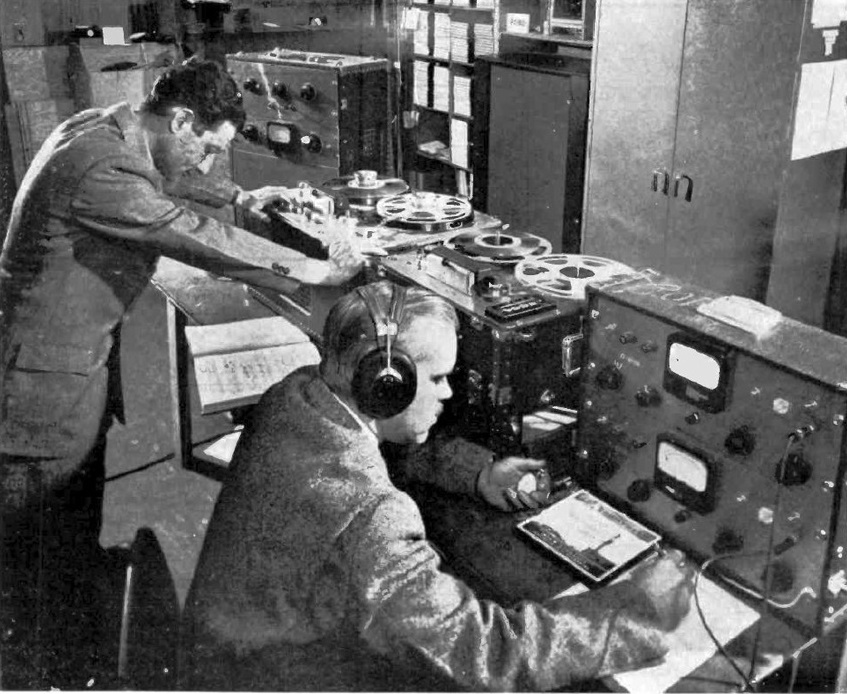
Hans Wolf & Ched Smiley
Les annonces de publications de bandes magnétiques stéréophoniques par de petites firmes (Livingston/Audiosphere et AV Tapes Library) ont créé une forte incitation pour les grands labels et en tout premier lieu RCA qui a annoncé dès juillet 1954 dans la revue High Fidelity sa première publication d’une bande magnétique en stéréo: Strauss Also sprach Zarathustra Chicago SO Fritz Reiner, enregistrement du 6 mars 1954.
Par la suite, les publications pionnières de Livingston sont progressivement tombées dans l’oubli jusqu’à la réédition en 2014 des enregistrements de Vittorio Gui sous le propre label du Festival «Historical Maggio Live» (2CD OF 003).
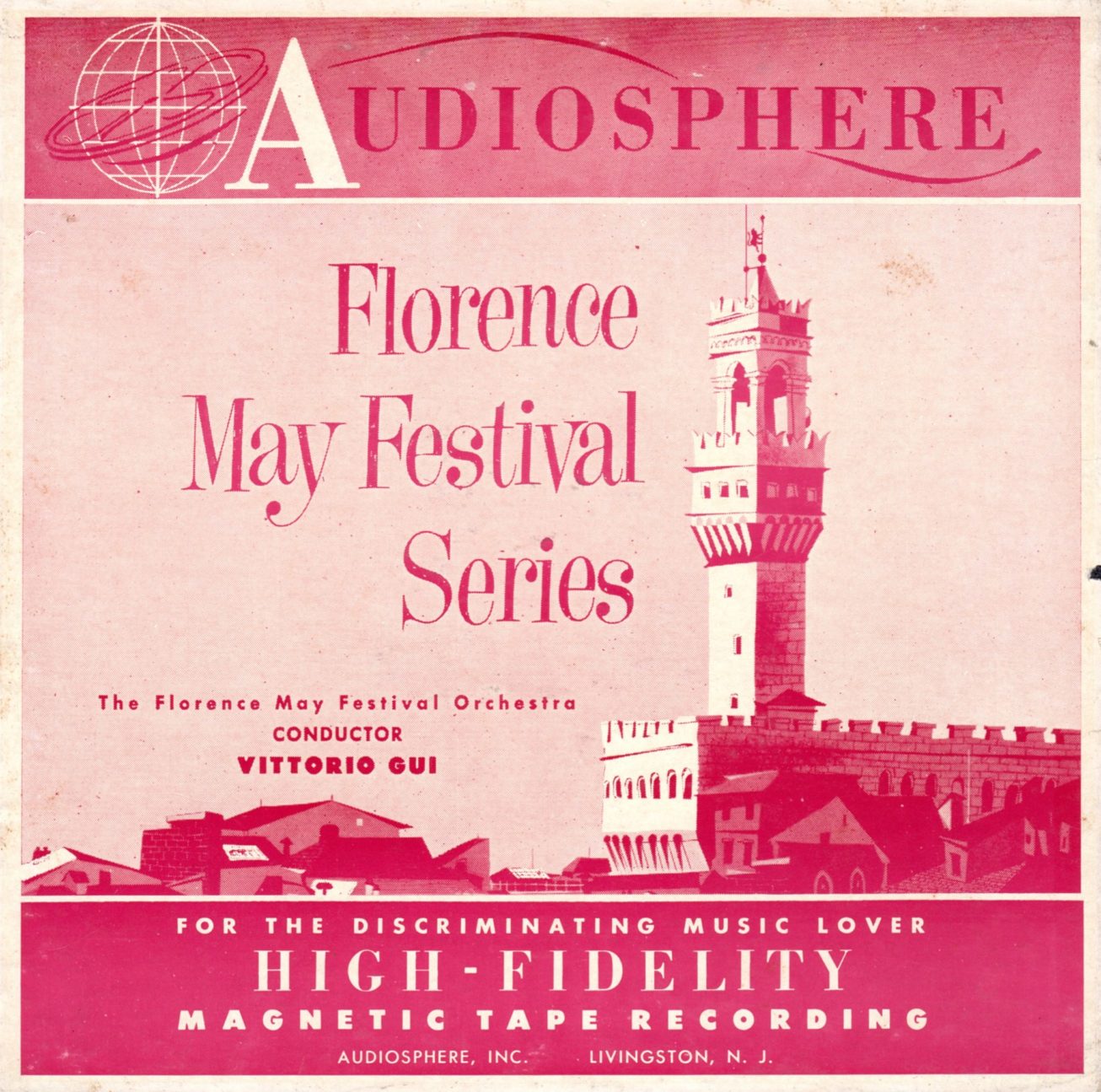
Bande /Tape Audiosphere BN701
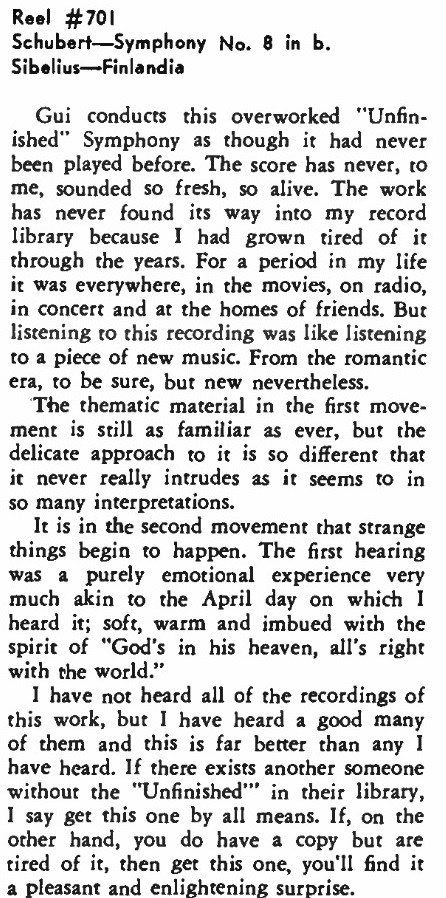

Bande /Tape Livingston 705-F
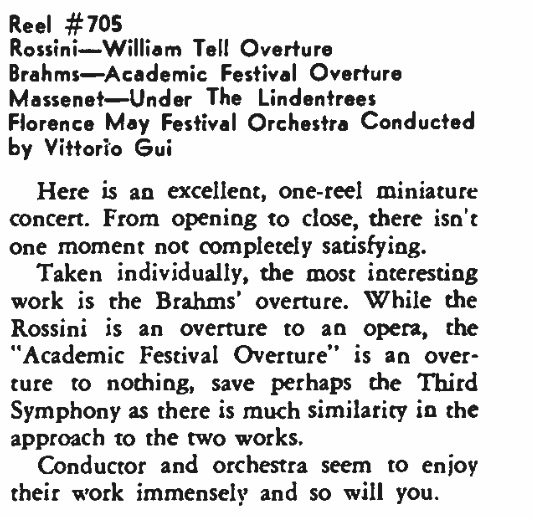
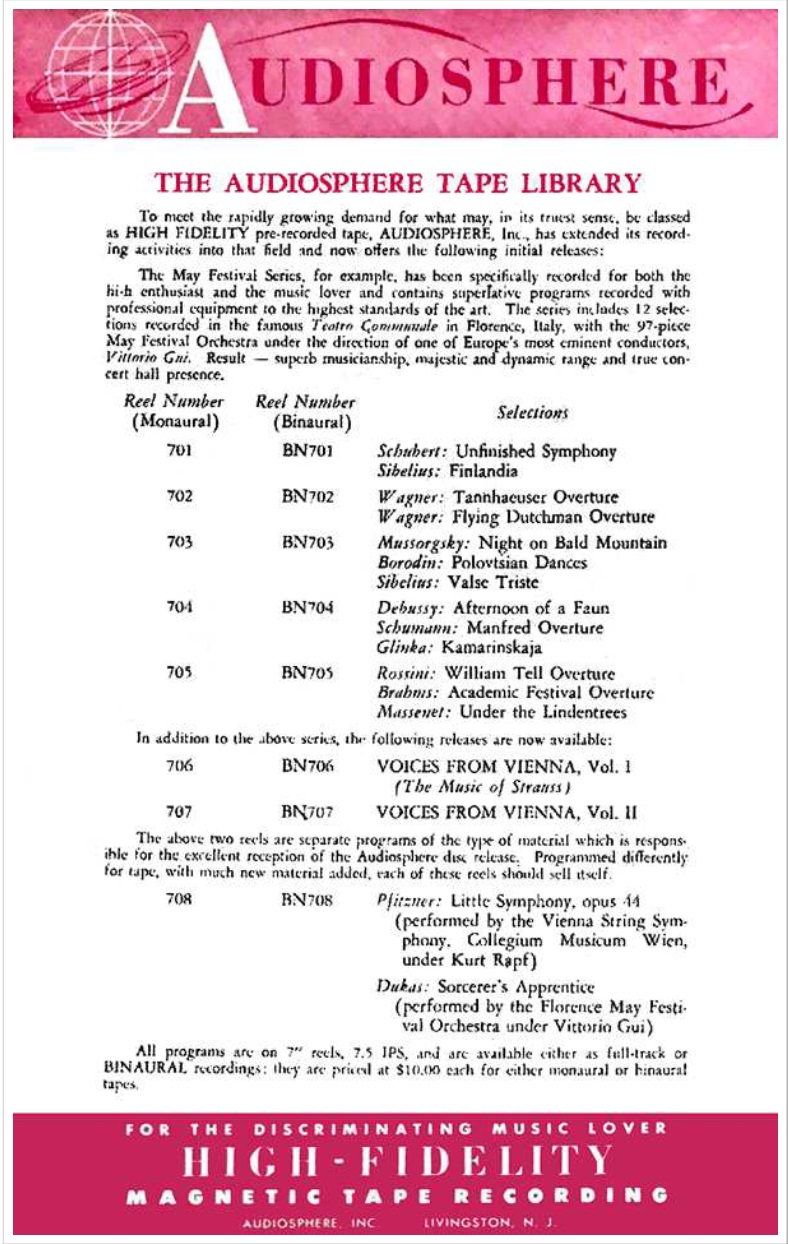
Audiosphere Catalog December 1954
The 1953 Florence May Festival (XVI Maggio Musicale Fiorentino) has remained memorable because of the performances of Cherubini’s Medea with Maria Callas conducted by Vittorio Gui.
But it is much lesser known that during this Festival, the first commercial stereophonic recordings in Europe were made with conductor Vittorio Gui, for the US Livingston label founded by Ched Smiley.
The musical producer was conductor Hans Wolf (Hamburg 1912- Seattle 2005). He studied among others with Heinrich Schenker in 1933 and 1934 and then further studied in Vienna. In the same way as Marcel Prawy who was his friend, he joined the US Army in 1943, became a US citizen and was sent to Vienna in the Spring of 1945. Before settling in the USA in 1952, he made recordings for the Remington label and the so-called «Austrian Symphony Orchestra « (which was in fact the Niederösterreichisches Tonkünstler Orchester) between 1950 and February 1952, as a conductor (Beethoven Symphonie n°5, Brahms Symphonie n°2, Franck Symphonie etc…). He was also the assisting producer to Marcel Prawy, for the recordings with Fritz Busch with the same orchestra (Haydn Symphony n°101, Beethoven Symphonies n°3 and 8) for which the recording engineer was Hans Sachs from the Austrian Radio (RAVAG) and, also worth noting, with Vittorio Gui (Mendelssohn: Symphony n°5 and Overture «Hebriden», as well as a LP comprised of overtures).
On the other hand, the Livingston label was then involved in research in experimental stereophony, especially with Emery Cook’s double groove LP concept, for which Livingston sold a tone arm called « Binaural Arm »:
The new Livingston concept that materialized in 1953 was the commercialization on stereophonic magnetic tapes of an important series of recordings made in Florence under the direction of Vitorio Gui during the May Festival which took place between May 7 and June 29, 1953. Livingston was not the only one with such an idea, but its stereo orchestral recordings were made before those of AV-Tapes Libraries (Sibelius: Cincinnati SO Thor Johnson recorded November 1953).
Five magnetic tapes (Ref: 701 to 705) issued by Livingston/Audiosphere have been announced in the June and August 1954 issues of the review Tape Recordings, just after having been presented to the public in March in Cleveland (Cleveland Chapter 18th Symposium «Stereo Symposium») as experimental stereo FM broadcasts.
Two days of the recording sessions in Florence were used just balancing the orchestra and the tapes were edited and played back on the spot for approval .
In an article titled «Tape makes it easier» published in the April 1955 issue of the review «Tape Recordings«, Hans Wolf unveiled his personal ideas as to recording on magnetic tape and on editing, and he described the unexpected visit of Heinrich Kralik, musicologist and Director of the music department of the Austrian Radio RAVAG, during the editing of Vittorio Gui’s recordings in a small room of the Teatro Comunale. To read it, please click HERE.
The advertised publications of stereophonic magnetic papes by small labels (Livingston/Auduiosphere and AV Tapes Library) generated a strong incentive for the big record companies and in the first place RCA which advertised as early as July 1954 in the review High Fidelity the publication of its first stereo tape: Strauss Also sprach Zarathustra Chicago SO Fritz Reiner, recorded March 6, 1954.
Later on, the Livingston pioneer efforts progressively fell into oblivion until the 2014 re-issue of Vittorio Gui’s recordings by the in-house label «Historical Maggio Live» (2CD OF 003).




9 réponses sur « Gui – Schubert Rossini Brahms Massenet Orchestra del Maggio Musicale Fiorentino 1953 Stereo »
HD/Hi-Res (24 bits/88 KHz):
https://e.pcloud.link/publink/show?code=kZ9HgLZR2ADRvHFiCk9V2rPQQHAsk7kAXpX
Format CD (16 bits/44 KHz):
https://e.pcloud.link/publink/show?code=kZMHgLZ7a75NHitJhyeriPpo5wkJkob1jLX
Great, the Schubert’s Symphony… and in such a historically important recording. Thank You!
Yes, the Schubert is quite stunning and the recording quality is truly outstanding. The tape is much better than the CD issue, which I believe has been submitted to noise reduction.
Other interesting items are the Wagner Overtures, but I could not find the tape.
The Florence orchestra lacks depth of sound for either Schumann or Brahms, and since Gui was renowned as a Rossini conductor, a bunch of Rossini Overtures would have been a better choice!
Thank you once again for a wonderful historical treasure!
Can you please tell us how we can purchase online the 2-CD Vittorio Gui set on the label ‘Historical Maggio Live’ ( 2CD OF 003 )? I could not find any link on the website to purchase CD’s. Thanks!
I suppose you have to create an account before buying online.
By the way, the list of CDs is very interesting:
« Il catalogo e questo »:
https://api.maggiofiorentino.com/code/wp-content/uploads/2022/06/Maggio-Live-Catalogo-2022-3.pdf
This CDs may be found on this site:
https://dischifenice.it/product-category/maggio-musicale-fiorentino/maggio-live/?v=11aedd0e4327
Otherwise, here is a link:
https://www.amazon.it/Conducts-Schubert-Schuman-Vittorio-Gui/dp/B00T5ELYB6
I found the official download of this 2 CD set on Qobuz for only $8.99!
https://www.qobuz.com/us-en/album/vittorio-gui-various-composers-orchestra-del-maggio-musicale-fiorentino/esdbbfi6xoykc
Great!
Fantastic post and so well documented ! Excellent sound for this program under the underrated Vittorio Gui.